Acer Aspire TimelineU M3: Life on the Kepler Verge
by Dustin Sklavos on March 13, 2012 5:56 PM ESTBattery Life
Getting detailed specifications for the Acer TimelineU M3 has been a little bit difficult; the notebook isn't on Acer's site yet (despite apparently having been released into the wild) and our reviewer's guide is a bit light on details. The box for it claims a meager 3-cell battery, but we're told it has a healthy 55Wh of capacity. That seems pretty dense, but as you'll see it's believable.
Unfortunately due to the crunch we don't yet have results for media playback, but those will be added as soon as humanly possible.
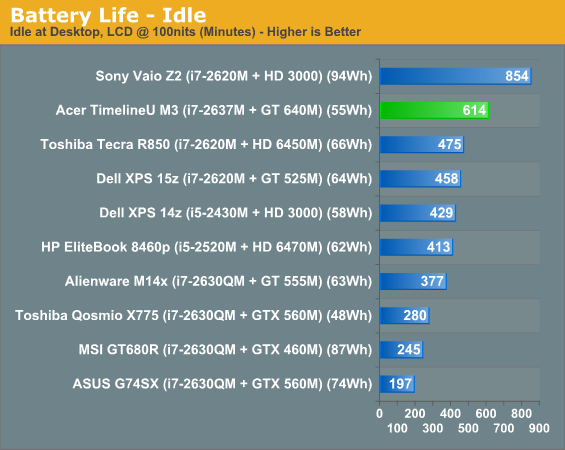
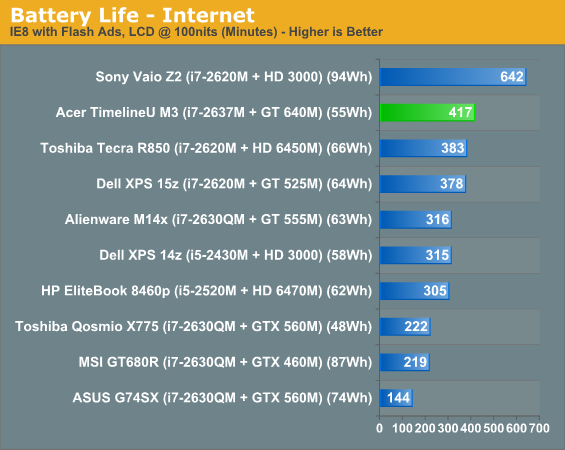
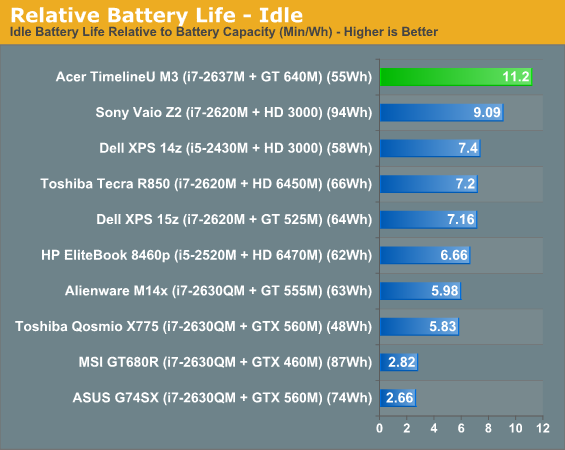
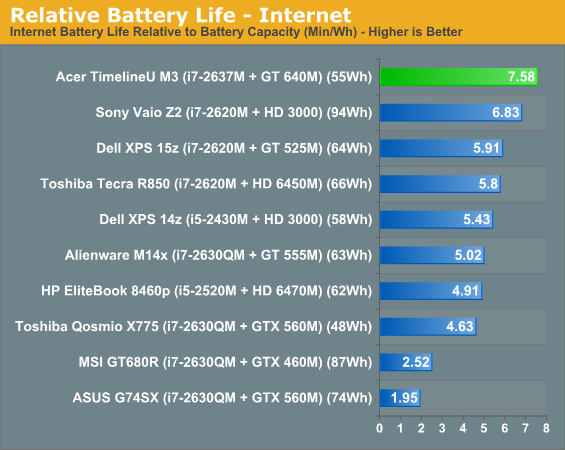
The TimelineU M3 absolutely rocks socks on the battery. NVIDIA's Optimus technology is in full effect here, and as a result the M3 is able to meet and beat the advertised eight hours of battery life that even the reviewer's guide for the M3 claims. This is one place where using the ULV i7-2637M does seem to pay major dividends compared to the full voltage chips.
Heat and Noise
Heat and noise are two more places where having that ULV chip seems to help the M3. While load noise isn't exactly ideal, it's only roughly 41dBA under load, and that's only when the GPU is being stressed. Meanwhile, no hot spots seem to develop on the top surface of the notebook. That said, top-center on the bottom of the M3 does get a bit warm; it's not uncomfortably hot and certainly won't scald you, but there's definitely a single sharp source of heat inside the M3.
Screen Quality
At the risk of digressing, when I used to write for NotebookReview I found myself trying to eschew talking about the speakers of the notebooks I reviewed whenever possible because the results were the same 99% of the time. That's remained true here; notebook speakers are typically only worth talking about when they're not terrible. The reason I bring this up is because I'm beginning to feel the same way when testing the notebook screens. It's obviously useful information, but this is a component that almost always underwhelms, and the same is true again with the Acer TimelineU M3.
While the 1366x768 resolution of today's mediocre TN panel is ideal for our bandwidth-constrained GPU, it doesn't require any feat of prestidigitation to say that the comments on this review will once again light up with well-founded complaints about a 15.6" screen running this resolution natively. Frankly it's just inadequate for a notebook this size, and we're going to keep harping about these subpar panels until manufacturers wise up and start getting it right.

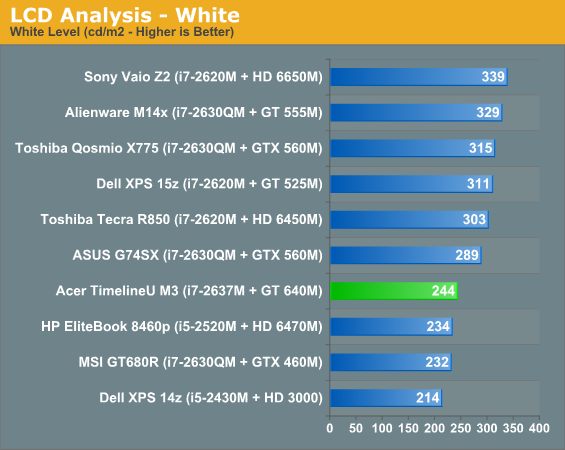

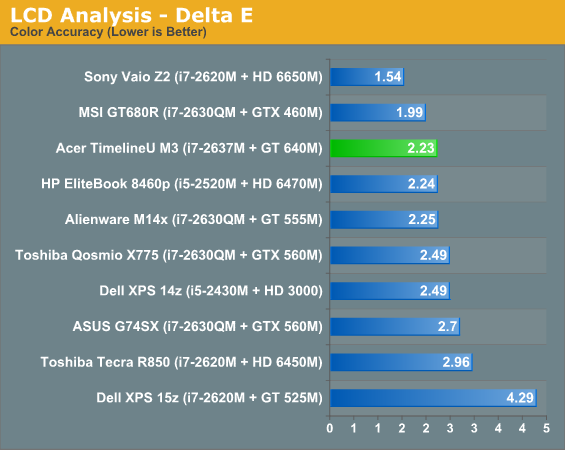
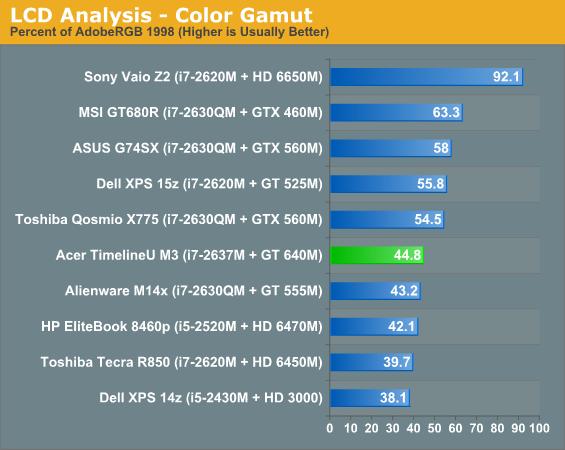
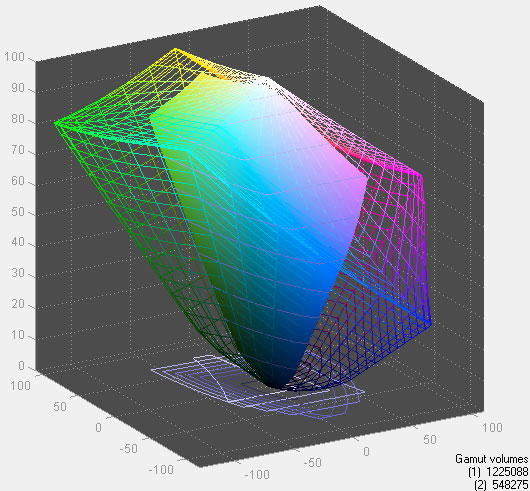
You can see from our test results that it doesn't necessarily have to be this bad. While the M14x's screen is underwhelming in places, it also runs at a superior 1600x900 resolution. The Sony Vaio Z2 may be a premium notebook (or at least a premium-priced one), but you at least see where some of that purchase price is going: a fantastic, high-resolution screen.
Meanwhile, the Acer TimelineU M3 sports the industry-standard dismal TN panel with weak viewing angles, low contrast, and low color accuracy and quality. This needs to change, and there's really no reason to settle for a crappy display when you're putting in 256GB SSDs.
And let's be clear about the costs: when an end user can go out and purchase a replacement AU Optronics B156HW01 v4 display for under $100 (compared to around $60 for a typical 1366x768 panel), the cost savings can't be that much for the laptop makers. Granted, with ultrabooks the manufacturers are also looking to get the thinnest panels they can find (another misguided goal in my book: thinness while sacrificing keyboard and display quality just doesn't make sense), but there are still much better 15.6" displays out there that would only increase the BOM by $50 at most.


_thumb.jpg)
_thumb.jpg)
_thumb.jpg)
_thumb.jpg)
_thumb.jpg)








76 Comments
View All Comments
lcarsos - Wednesday, March 14, 2012 - link
Oh my the screen is 768p? I would certainly hope that the screen is refreshed in a progressive manner! If my cursor were to start interlacing as I moved it around I would probably start a bar fight.My point is, why would an unnecessary descriptor such as "progressive" get slipped into a laptop review? Man up, and display the screen pixelage, of course the laptop is going to display things progressive it wasn't a television designed in the 60s. Now if you were to stick a DVD in there, DVDs are encoded interlaced in most cases. Now what's happening? A progressive display of interlaced images? Better to just leave that out of the review.
Also, 1366x768 in a 15.6" laptop? What committee let that through? In an age where the iPad can end up with 2048x1536 pixels in a 10" screen for $500 they can certainly slip in a higher quality screen at the price they are currently at. Even if it is still a TN panel. I have a 14" Thinkpad with a 1600x900 display, at no point should a screen of larger size come with lower resolution.
Glock24 - Wednesday, March 14, 2012 - link
I've been looking for a laptop to replace my aging Asus F8Va (which has a 14" 1440x900 screen), but every single manufacturer insists on using crappy 1366x768 screens. And I say crappy screens not just because of the resolution, but also because of the poor viewing angles and bad contrast.I remember some older notebooks sporting 4:3 screen with at least 1280x1024 resolution. Then came the 16:10 craze and the screens started coming with 1280x800 resolution. Now we have 16:9 screens with 1366x768 resolution. What's next? 1440x600? 1600x400?
Having 768 vertical pixels feels so 90's. Come on! Even my old 19" Samsung CRT sm997mb, which was in no way top of the line, could diplay 2048x1536@60 (1600x1200@75, 1280x1024@85), and it was made in 2004. I know CRTs are different animals, but I think I made my point.
I'm not much into the "ultrabook" thing, but I prefer a 14" latop over the more common 15.6" form factor, and I want to play some games on it from time to time, so a dedicated GPU or a decent APU is required. I was considering the Lenovo y470p, which is a 14" laptop with Radeon HD7690, a very good port selection and a great price, but why does it come with a mediocre screen!
HP makes some decent laptops, the DV6 is interesting, and some of them have a 1080p screen option, but are 15.6" or 17"
Also, as some others said, why not ditch the optical drive and use the space for something more useful? An additional battery, some more ports, etc.
Johnmcl7 - Wednesday, March 14, 2012 - link
It's not the case that every company only offers 1366x768 screens, my current Vaio is approaching three years old for the model and has a 1600x900 13.1in screen and the model after it (now also retired) offered a 1080p 13.1in screen with decent colour and viewing angles. 13in higher resolution panels are trickier to find but 14in is fairly easy, there's quite a few other with 1600x900 panels.I do love that in the comments as always people are saying how Apple will lead the way with high resolution displays despite Sony offering 13.1in 1080p panels for a couple of years now. As usual Apple are first to do something by being several years behind those that are genuinely at the front.
As for the why with mediocre screens, I would think it's obvious - most people don't care and won't pay for them. I don't agree with that stance but on supporting a large number of these crappy 1366x768 screens both at work and out of work laptops, not one person has every complained to me about the low screen resolution. It tends to be the other way round if anything, people tend to complain about my high resolution panels because they make everything too small.
John
Finraziel - Thursday, March 15, 2012 - link
Yes, Sony does make nice laptops with sometimes nice screens... The problem is that you pay through the nose for them. When a 500$ laptop offers enough performance for me, and the added cost for a decent screen would be about 50-100$, then why can't I get one of those screens unless I buy a 2000$ laptop?As for Apple, I don't think the majority of people saying that in the comments here are fanboys or even saying that Apple would be the first, but it does seem to be the case that whatever Apple does, other manufacturers copy. I'm not even saying that it's to Apple's credit as a technology company, it says more about their marketing department. I actually would never buy anything from Apple because I don't agree with their philosophy and most of their products and think they're a bunch of stuck up snobs (from professional dealings with them), but I would like it if they could jumpstart a trend to include better screens in laptops.
zepi - Wednesday, March 14, 2012 - link
How about the battery life when gaming? Is it still a dismal 1 hour or so? How about when compared to let's say a Llano laptop?kmmatney - Wednesday, March 14, 2012 - link
Hey Acer! Do you want to stand out and be more like Apple? Then how about making a laptop with a 16:10 screen?HighTech4US - Wednesday, March 14, 2012 - link
Why exactly do manufactures chose slower and more power hungry GDDR3 over GDDR5?You would think the lower power and higher performance of GDDR5 would make it the obvious choice.
Is the cost of GDDR5 really so much higher than GDDR3?
ueharaf - Thursday, March 15, 2012 - link
you have to compare with amd 6630m on a sony vaio SA.z2 has thunderbolt so is not a fair comparison in graphics card. Here I smell a NVIDIA propaganda, rather than a fair comparison of the graphic cards...come on!!!
Kansja - Thursday, March 15, 2012 - link
Keep this in mind: Due to the much lower thermal headroom in a laptop you can't just stick in enough power to fire up 1080p displays on a laptop, either from the graphic's side or the power constraints (Remember that the iPad has a MASSIVE battery for the power consumption of everything minus display)You can't just stick 4 580's on a lap. It's a compromise between costs to the user, mobility and performance. I do agree 1600x900 should be an standard but it's not possible until our graphic's card offer 6870 like performance on 10-20W power envelope
Old_Fogie_Late_Bloomer - Thursday, March 15, 2012 - link
I had to log in to say this...looking at the results on the gaming performance page, it seems to me that this laptop is able to acquit itself quite well at 1600x900. Honestly, my next laptop will be 1600x900 at 15.6" (unless I need to get a really cheap machine for some reason) and if this model had a matte, 900p display, it would be on my short, SHORT list, especially given the pleasant experience I've had with my current Acer laptop.There's really just no excuse for Acer (or anyone) to not put a higher-resolution display on a machine like this. I don't need (or want) 1920x1080, but I'll be damned if I spend more than $600 on a laptop that doesn't have at least 900 rows of pixels on the display.